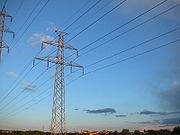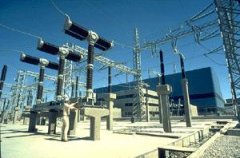How does electricity get to your home or business?
First, we must understand that electricity is consumed as soon as it is generated. Unlike other forms of energy, electricity cannot be stored affordably. And, since electricity travels at the speed of light (approximately 186,000 miles per second) it has a very short shelf life, so to speak. Therefore, a very complex set of controls must be in place to balance supply with demand.

Since most power generation plants are miles away from the areas they serve, high voltage electrical transmission lines must be run (pictured left). It’s not uncommon for these lines to run for hundreds of miles before reaching their service destination.
These high voltage transmission lines criss cross the country originating from
about 10,000 power plants creating what is commonly known as ‘The Grid’. According to the U.S. Department of Energy, America operates approximately 157,000 miles of high voltage transmission lines. Many of these lines transmit electricity in excess of 230kV (or 230,000 volts). There are three major ‘Grids’ in North America. They are The Western Interconnect, The Eastern Interconnect and the Electric Reliability Council of Texas (or ERCOT).
Once the transmission lines reach their destination they are received at sub-stations. It is at the sub-stations that the electricity is transformed down to a much lower voltage for distribution around a city or town. And, although it is a much lower voltage (13 – 17kV typically) it is still much to high for home or business use. These distribution lines are usually run through neighborhoods on tall wooden poles.

We finally get to your home or business. From the distribution pole before power can be sent to your building the voltage must once more be transformed down. This is either done with transformers mounted on the pole itself or via a ground mounted transformer on your property. The final voltage entering your building will vary depending on what type of building it is. Typically if the building is a dwelling the voltage serving it will be 120/240 volts. Commercial buildings many times are served with 480/277 volts, which is typically a 3 phase system not suitable for dwelling buildings. The local power utility provides the power from their transformer to your electric meter.
This is where we come in. All wiring into the building from the electric meter belongs to the end user or owner of the building. This wiring must be installed and maintained by professional licensed electricians.